Moto X Review
by Brian Klug on August 26, 2013 1:30 PM EST- Posted in
- Smartphones
- Qualcomm
- MSM8960
- Motorola
- Android
- Mobile
- Android 4.2
- Moto X
CPU Performance
by Brian Klug & Anand Shimpi
I already touched on it, but inside Moto X is Motorola’s X8 Mobile Computing System, which consists of a 1.7 GHz Qualcomm Snapdragon S4 Pro MSM8960Pro SoC with two Krait 300 CPUs running at 1.7 GHz alongside Adreno 320 graphics. The two other parts are a TI MSP430 for sensor fusion and active display and a TI C55x DSP for voice activation. There’s a total of 8 “cores” in there, which is where the 8 in X8 comes from, but beyond that there’s no getting around the fact that there’s an 8960Pro inside the Moto X responsible for actually powering the OS.
The elephant in the room is of course the fact that Motorola has gone to great lengths to both avoid talking about the dual core SoC, but instead wants to talk about its “8-core system”, which is curious, since it simultaneously plays its dual core SoC choice as a strength. There was nothing wrong with 8960, it was a great SoC and appeared in countless flagship phones in 2012, and its respin with 8960Pro presents a number of good upgrades. Qualcomm’s 8960Pro includes Krait 300 instead of 200, bringing a jump in clocks from 1.5 to 1.7 GHz and higher IPC at the same time, and the Adreno 225 graphics are out and replaced with Adreno 320 which is considerably faster and OpenGL ES 3.0 compatible. 8960Pro is fine, but it’s an SoC just short of high end even by Qualcomm’s own roadmaps, even though the Moto X is positioned and priced at launch like a high end phone.
“Why would anyone pay $199 when they can get latest SoC-based gear for that much.”
That’s the question which was posed to me, rather eloquently, by another AnandTech editor. I found myself wondering the same thing when I heard the $199 on-contract pricing at the Moto X announcement. Given prior information about the Moto X including an 8960Pro, I assumed a different price point entirely than the usual, and still expect it to come down in price rather quickly. There’s obviously more to a device than just what silicon is inside, but this is the performance section after all. Trading off two CPU cores for integrated modem with 8960Pro does likely help Motorola to make a smaller device and spend less money on silicon, it’s ultimately a tradeoff.
If we look at SunSpider, Octane and Kraken, you wouldn’t be able to tell that the Moto X used a dual-core Krait 300 vs. a quad-core offering. In all three benchmarks the Moto X delivers performance similar to the quad-core HTC One and Samsung Galaxy S 4 (US model) despite having half the cores. The other two “cores” in the X8 system are dormant in these tests, so that’s not why the Moto X is so competitive. I also tried running Chrome on the SGS4 and still saw remarkably similar performance.
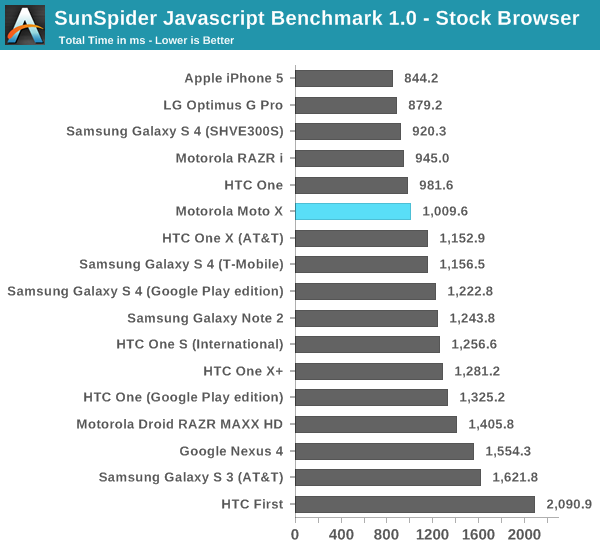
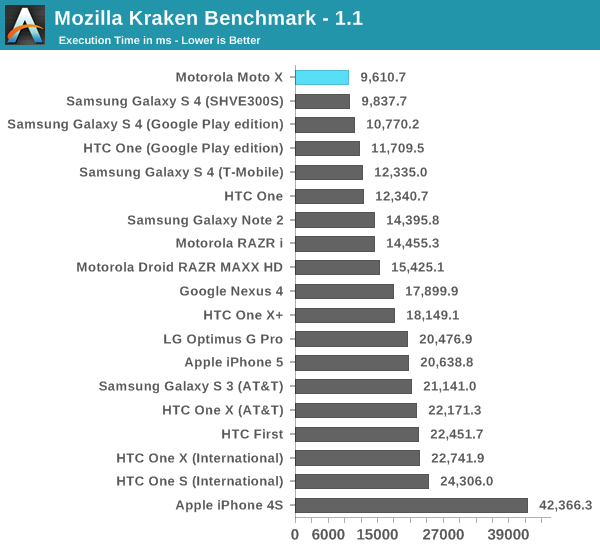
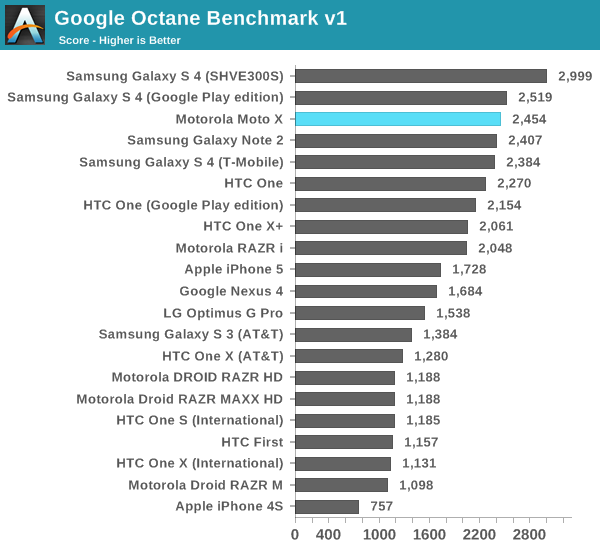
In our Nexus 7 review I pointed out that the SGS4’s 1.9GHz top frequency wasn’t consistently attainable. The end result was a smaller than expected difference in performance between its 1.9GHz Snapdragon 600 and the 1.5GHz Snapdragon 600 used in the Nexus 7. I wondered if something similar might be happening here with the Moto X.
To find out I profiled CPU frequency of each core on the Moto X and Galaxy S 4 while running Kraken and SunSpider:
Looking at the first core on the Moto X we see that it’s active almost all of the time, and almost always running at its top speed of 1.7GHz. The second core is also active but we see it regularly alternating between ~950MHz and 1.7GHz.
Now let’s look at the quad-core SGS4:
Max CPU frequency tops out at 1.9GHz, as it should, but it’s sustained for only a very short period of time. Instead we see the first core step down to 1.5GHz, then again to 1.25GHz before eventually settling down to around 1GHz. We see the same pattern on the SGS4’s second core.
Looking at the third and fourth cores we see why the first two cores are more frequency limited. There’s fairly regular use of the third core, which eats into the SoC’s overall TDP and seems to force clock speeds down of the first two cores. The fourth core gets less use but it also contributes to driving frequencies down across the board.
We see the same sort of behavior in SunSpider, with the Moto X regularly hitting 1.7GHz while the SGS4 has more active cores, running at lower overall frequencies.
The tradeoff is an interesting one. Single threaded performance tends to govern system responsiveness (at least within a given application) more than multithreaded performance. However, running one core at 1.7GHz will require a higher voltage than running four cores at closer to 1.2GHz. Depending on the workload, four cores running at lower frequencies/voltages could actually end up being more power efficient than running two cores at their max frequency/voltage.
I actually wonder if that might be why we see worse battery life on the Moto X in practice compared to the HTC One/SGS4. Heavier workloads that keep all four cores active, but not pegged, might actually run more efficiently on the quad-core Krait 300 platforms.
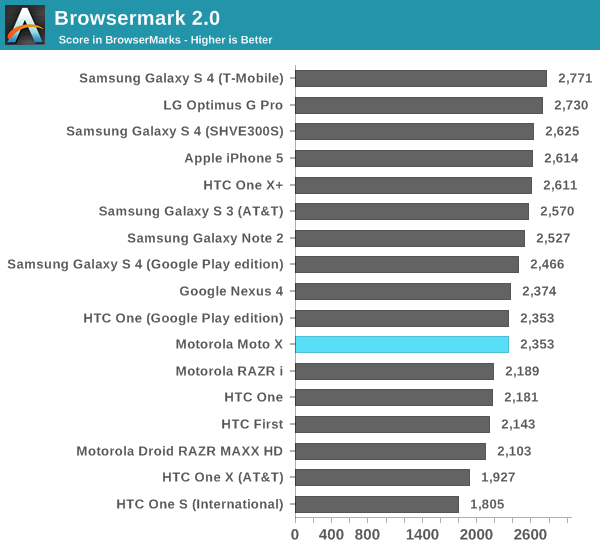
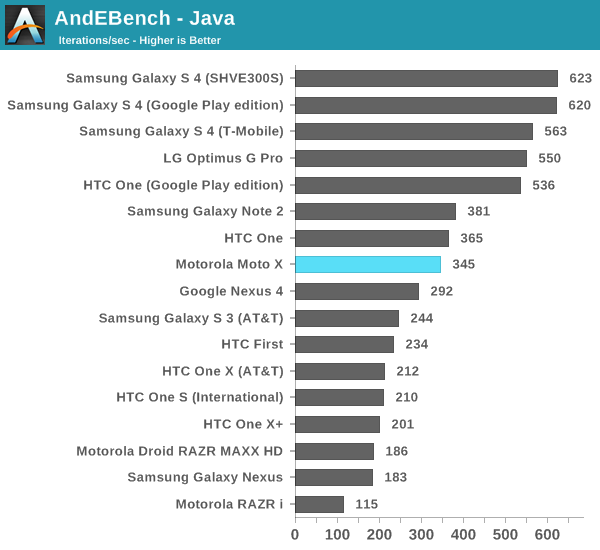
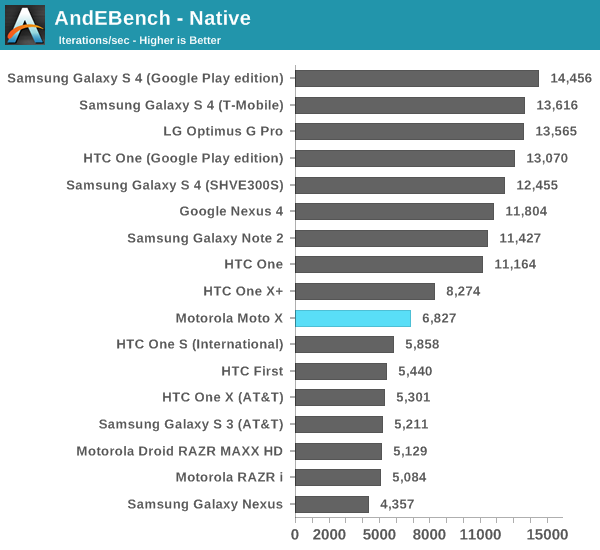
AndEBench includes a multithreaded component, which presents a different picture of the Moto X vs. the quad-core competition. In practice I find the Moto X’s performance is really quite good. Depending on your usage model you may or may not notice the difference between it and a quad-core offering because of the higher sustained one/two core frequencies. The downsides are potentially lower battery life as it typically takes a ton of voltage to run these cores at their max frequency, and the fact that Motorola doesn’t pass along any of the cost savings from going with a cheaper SoC/platform to the end user.

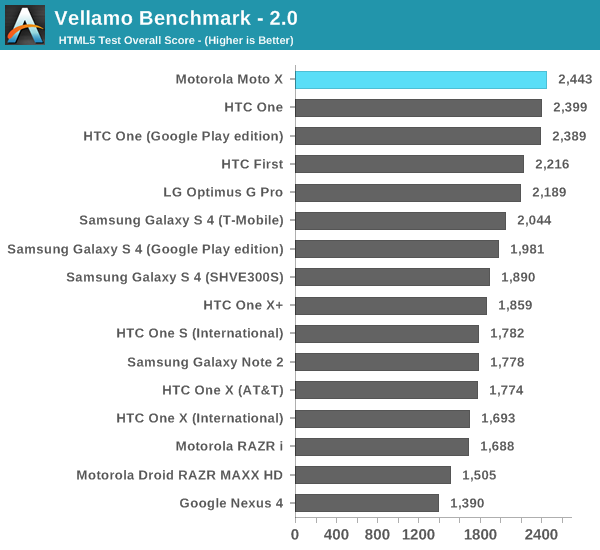


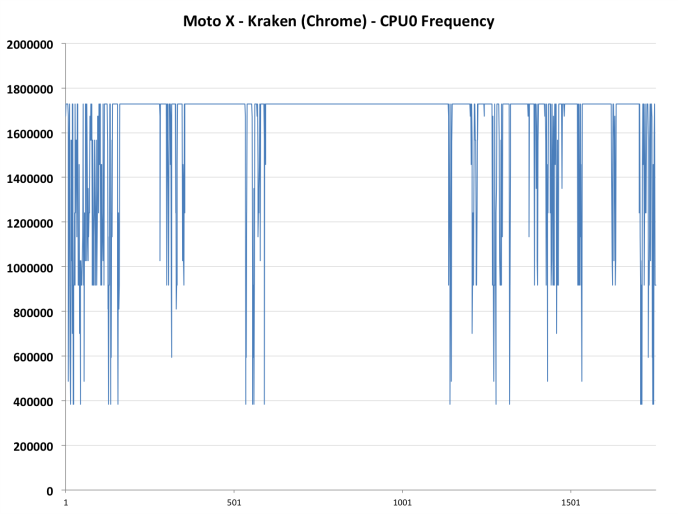
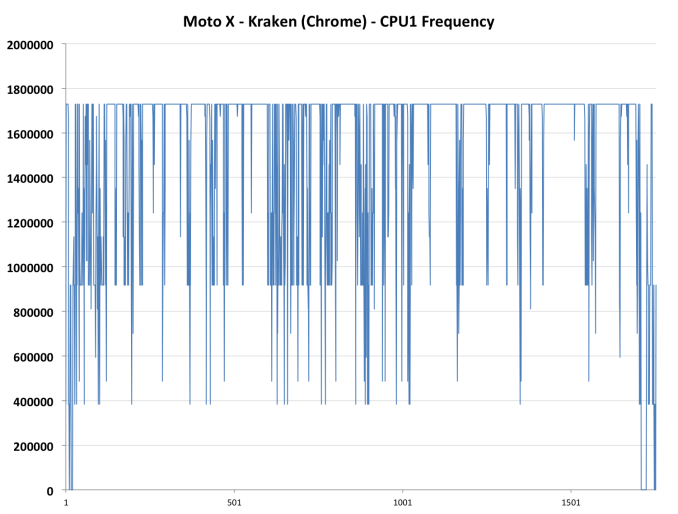
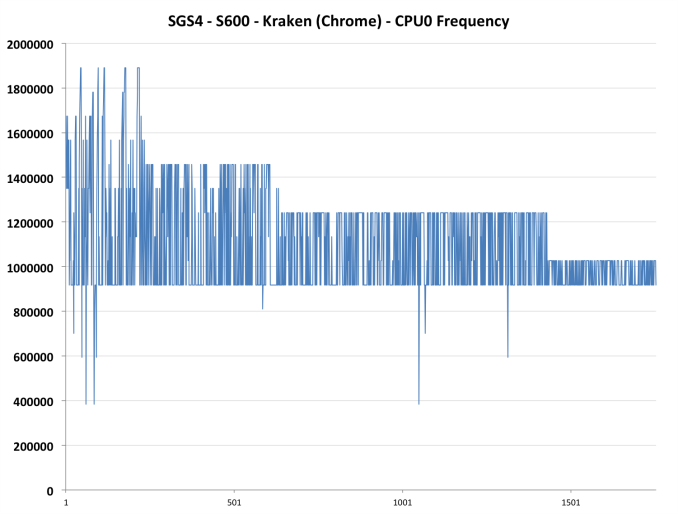

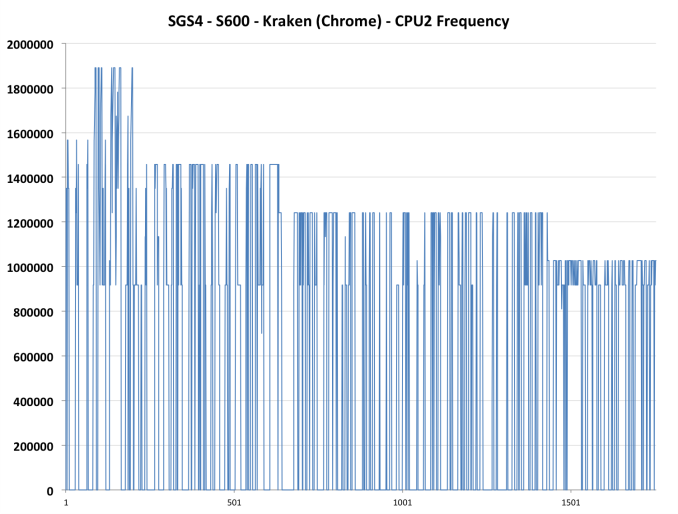
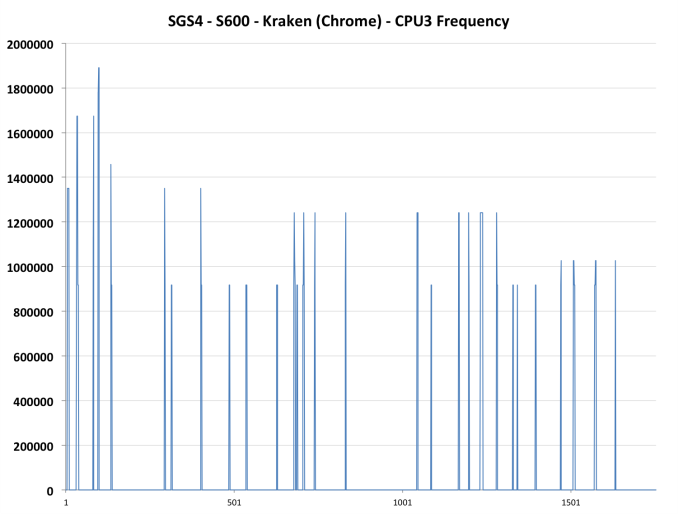
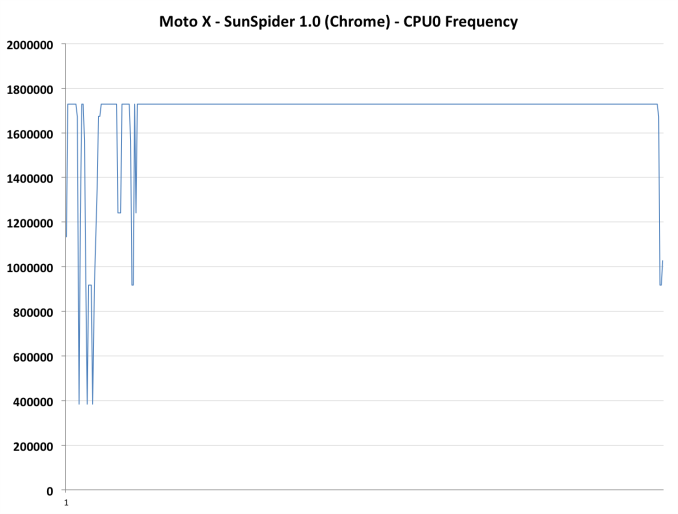

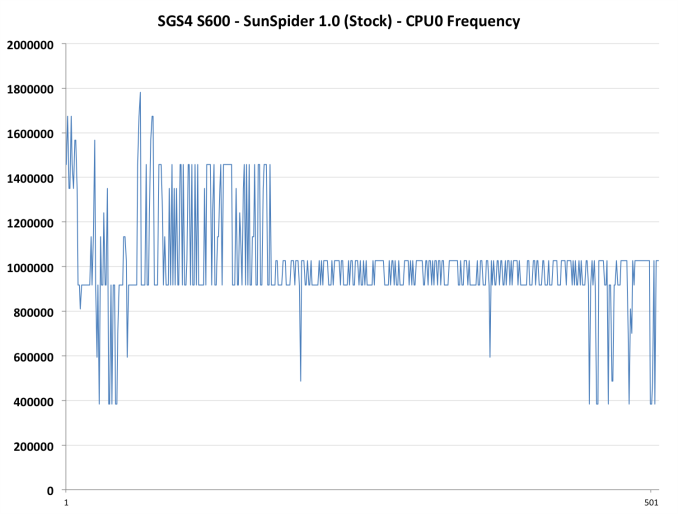

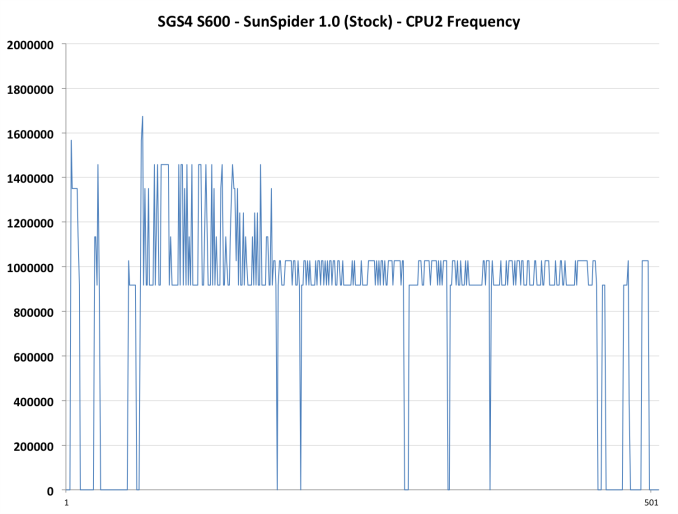
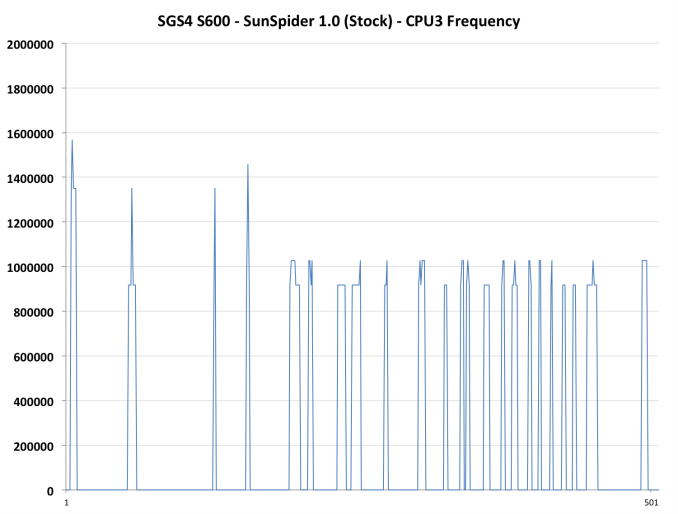








105 Comments
View All Comments
SomeGuyonaBike - Tuesday, August 27, 2013 - link
I understand and agree with general objections to carrier-installed bloatware (and because of this I won't decide whether or not to buy a carrier-branded X until details about the developer editions are public)... I'm just curious as to why reviewers are so negative about this particular piece of carrier bloat.Impulses - Tuesday, August 27, 2013 - link
I think I disabled it on my sister's One X, wasn't really an issue...SomeGuyonaBike - Tuesday, August 27, 2013 - link
I spent a few minutes playing with a demo unit at an AT&T store over the weekend. When I launched the "People" app it wanted to sync to an AT&T address book, but there was an option to decline. I wonder if opting out of using the AT&T address book is a permanent thing, or if you have to repeat the opt-out every so often.Tralio - Wednesday, September 11, 2013 - link
AT&T address book is a bit of an annoyance for everyday use, even on the X it tends to open incredibly slow. On the other hand when switching to my X it imported all my contacts onto my device without needing to import from sim. This can be an issue when switching from some of motorola or other developers' older models with larger sims, especially with the X not having an sd card slot and not every user knowing they can import/export from their comp. On a side note though for at&t users (not sure about the rest of the carriers) all at&t stores have a sim cutter that they can cut your sim down to the smaller size if you'd prefer to import from your current sim card or just don't want to deal with activating the new one.jasperjones - Monday, August 26, 2013 - link
Brian,I agree that smartphone line out/headphone out sound quality is still a bit of a challenge. Looking forward to your new audio test suite. It would be great if you guys could report RMAA results.
Brian Klug - Monday, August 26, 2013 - link
I like RMAA, but it's easy to get a lot of things wrong and isn't really mobile workflow friendly. We're going to try something different that's a lot more robust :)-Brian
synaesthetic - Friday, September 6, 2013 - link
The thing I would like most, that I can't seem to find anywhere for any smartphone, and something that affects audio quality with headphones to a greater degree than any other attribute...Output impedance.
Please, for the love of all that is holy, why can't at least one device reviewer measure the output impedance of these phones?!
cheinonen - Monday, August 26, 2013 - link
I should find out this week if I'll have access to a new suite of tests or not. If I can do it, RMAA will look like child's play in comparison. Believe me, we're looking forward to it.Impulses - Tuesday, August 27, 2013 - link
Are you gonna go back and test at least this year's flagships? It'd be nice to have a baseline, particularly since this is something manufacturers have supposedly emphasized (HTC with the One, LG with the upcoming G2).cheinonen - Tuesday, August 27, 2013 - link
It looks like I'll have access to some new testing methods, but it will be a month or so until I can do them all probably (sorry, I have a large backlog of other things to get done right now). I'll plan to do a huge initial round-up of phones and tablets to get a baseline and create an article about the new tests. I also want to point out that audio tests might not run with the initial phone tests since Brian or anyone else will have to ship the phones to me in Oregon to test and it'll take them out of the hands for a few days.We haven't tested this yet, but we're hoping it really helps us set a standard for audio testing of phones and tablets.